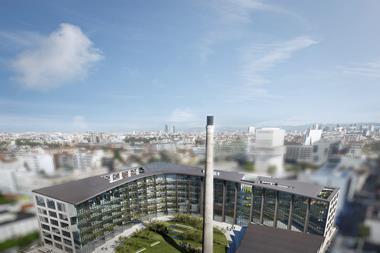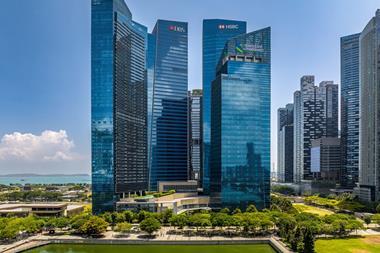Timothy Bellman and Shane Taylor focus on four of Asia's major office markets and stress that selection based on low supply elasticity will be crucial in minimising future risk
A booming financial services industry, an expanding multinational corporate presence, and broadly based, strong economic growth have underpinned robust office space absorption in many Asian markets in recent years. The take-up of space to accommodate rising numbers of white collar employees has been especially impressive over the past two years and, as a result, the vacancy rates for prime and Grade A office space are at or near historical lows in most office sub-markets throughout the region.
With much demand generated from the recent surge in financial and business services, are office markets in the region vulnerable in the event of a downturn in capital markets and the financial services environment? Although there is a risk, most economists expect that at the worst the very strong global growth of the past few years will give way to strong global growth in 2007-08. Under such conditions the demand for office space should remain strong. In these circumstances we believe it will be variation in the supply-side response that becomes the main factor differentiating office market performance across the region.
Currently, conditions in most large office markets in the region suggest they are well positioned in the rental growth stage of their cycle (see figure 1). The speed at which these growing markets move to maturity or contraction will be influenced not only by the demand outlook but also by their supply elasticity as growth in market rent approaches the level needed to justify construction. What is supply elasticity? It is the ease with which a market can respond to market signals such as a falling vacancy rate or rising rent with new construction. Certain inherent features in a real estate market can lead it to be elastic or inelastic, such as the availability of developable land, the permissiveness of local planning and building regulations, and local market structure, especially the norms for project finance. Differences in supply conditions will help determine rental growth and total return prospects going forward.
How do supply conditions look? Figure 2 illustrates the relationship between vacancy conditions and the supply response in several major office markets. On the Y axis, each market is positioned to illustrate its current vacancy rate relative to its long-term vacancy rate; a broad proxy for the ‘frictional vacancy rate' or the approximate tipping point at which real rental growth/decline begins. The X axis measures the supply response forecast over 2007-09, specifically considering construction in the pipeline over the next two years as a proportion of current stock. It is evident that in all markets current vacancy rates are much below their long-term averages. However, there is a strong pipeline in several markets (those to the right of the graph). These markets may be more vulnerable, especially if the new supply were to coincide with a weakening of national and/or global financial markets.
A top-down strategic look at Asian office market trends is useful but is clearly insufficient without an understanding of local market peculiarities that are highly relevant in determining the attractiveness of markets and in timing entry and exit opportunities. For instance, the Hong Kong Grade A office market cycle has been more influenced by demand-side factors historically than by supply-side factors. Previous cyclical turning points were triggered more by a demand-side shock than by construction even though the Hong Kong market is relatively elastic in its supply-side response. This cycle could be different.
In the current cycle, surging demand has brought the vacancy rate in Central well below its long-term average and well below the widely accepted 10% mark. The result has been record rent levels for top quality space. The result has also been the prospect of new construction, particularly in the decentralised areas. Coupled with the potential for slightly slower growth in office demand in the near future, this high level of new supply would likely be a trigger for the Hong Kong office rental cycle to stabilise or turn. Indeed, there is already evidence that the upward pressure in Central is moderating and evidence in the decentralised areas that rents are down from their peak level.
Demand in Singapore took longer to pick up in this cycle than in Hong Kong. As a result the cycle is later but is now in full swing. According to CBRE, occupancy costs increased by over 50% in the year to the first quarter, the fifth fastest rate worldwide and the fastest for a major financial centre. Although no construction is due to be completed in Singapore for the next two years, traditionally it has been a market with high supply elasticity. The provision of an adequate supply of land for development is a key feature of government policy, as illustrated by the development of the Marina Bay Financial Centre on reclaimed land close to the existing Raffles Place CBD. The first phase is due to be completed in 2010. Until then, the outlook is for the vacancy rate to dip below 2% and for rents to continue to increase. At US$68/ft2 per annum (70% of Hong Kong levels), Singa¬pore office rents have considerable upside potential before international competitiveness becomes a concern.
Shanghai's exceptional growth in demand is coming from financial service providers trying to establish a foothold in mainland China's finance centre since the liberalisation of the sector in late 2006. Anticipating this strong demand, landlords have been able to raise rents strongly since 2005 in the Pudong office market. With only a limited number of buildings of premium quality, to date demand has been able to absorb any new building comparatively easily. However, the 2006 liberalisation also triggered significant speculative office development with supply likely to peak in 2008-09, reducing upward pressure and perhaps putting downward pressure on rents. An abundance of land makes Shanghai's Pudong sub-market relatively supply elastic.
We would characterise Tokyo as having medium supply elasticity. It is not easy to assemble sites but a wave of construction is now under way catering to pent-up demand. Demand has outpaced a surge in Grade A office supply since 2003. Much of the new construction is through the redevelopment of existing properties or on rail station development sites. New office supply in the Tokyo Central 5 Wards office market in 2006 increased to 165,000 tsubo (over 5.8m ft2), although this was only half the volume of 2003, when a substantial number of new large buildings became available. Demand was even stronger, leading to a sense of scarcity with respect to good properties. Although supply totalling 206,000 tsubo (over 7.3m ft2) is expected in 2007, many buildings are attracting tenants at a steady rate, so the tight supply and demand balance will likely continue.
With comparatively little variation in yields across the world, those markets with medium or high supply elasticity carry greater risk. New construction may erode further rental growth prospects even under a benign scenario of continued growth in demand. The risks will become even more pronounced under a scenario of significantly slower economic growth. If this scenario comes to fruition there is a threat that the prospect of an erosion of rental income will be priced into yields. How to mitigate this risk? At this point in the office market cycle, long-term investors in Asian office markets would do well to focus on those markets with lower supply elasticity, particularly those in which the current vacancy is low compared with the long-term average.
Timothy Bellman is managing director, global head of research & strategy, at ING Real Estate; Shane Taylor is associate, global research & strategy, at ING Real Estate












